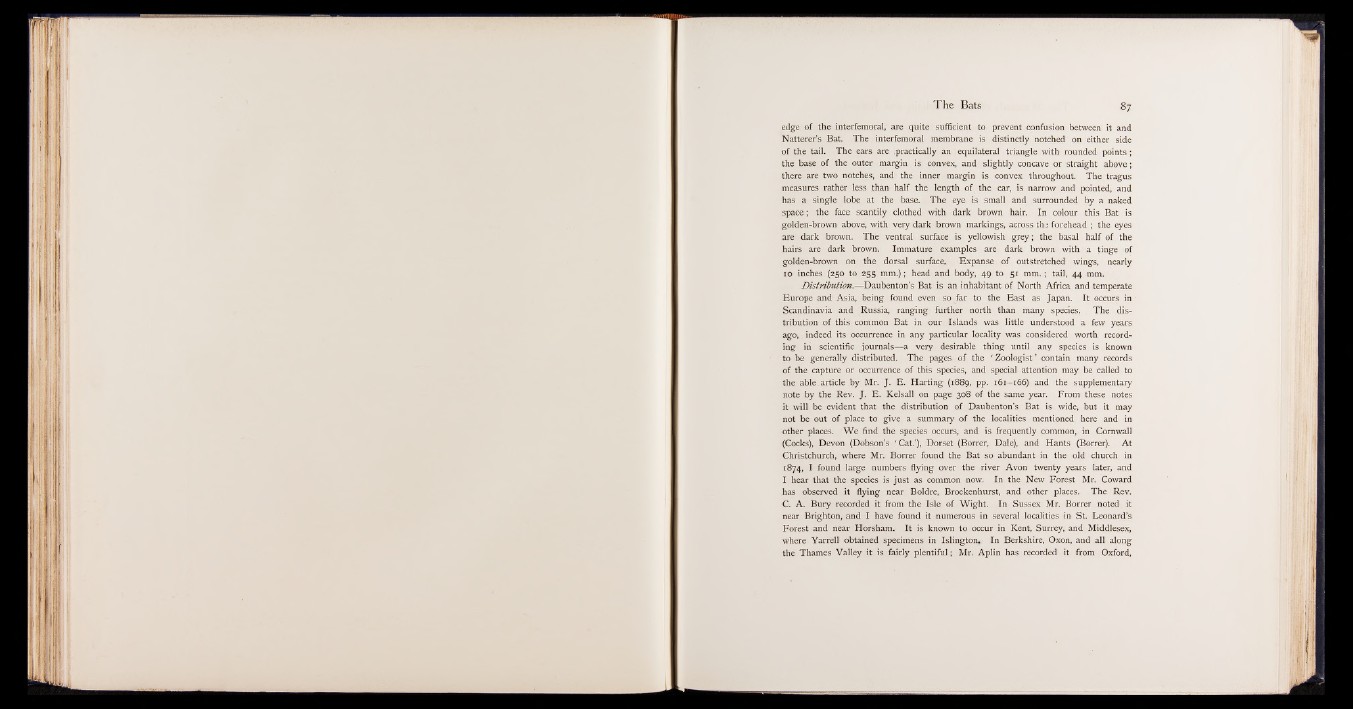
The Bats 8 7
edge of the interfemoral, are quite sufficient to prevent confusion between it and
Natterer’s Bat. The interfemoral membrane is distinctly notched on either side
of the tail. The ears are practically an equilateral triangle with rounded points;
the base of the outer margin is convex, and slightly concave or straight above;
there are two notches, and the inner margin is convex throughout. The tragus
measures rather less than half the length of the ear, is narrow and pointed, and
has a single lobe at the base. The eye is small and surrounded by a naked
space; the face scantily clothed with dark brown hair. In colour this Bat is
golden-brown above, with very dark brown markings, across tha forehead ; the eyes
are dark brown. The ventral surface is yellowish grey; the basal half of the
hairs are dark brown. Immature examples are dark brown with a tinge of
golden-brown on the dorsal surface. Expanse of outstretched wings, nearly
10 inches (250 to 255 mm.); head and body, 49 to 51 mm.; tail, 44 mm.
Distribution.— Daubenton’s Bat is an inhabitant of North Africa and temperate
Europe and Asia, being found even so far to the East as Japan. It occurs in
Scandinavia and Russia, ranging further north than many species. The distribution
of this common Bat in our Islands was little understood a few years
ago, indeed its occurrence in any particular locality was considered worth recording
in scientific journals— a very desirable thing until any species is known
to be generally distributed. The pages of the ‘ Zoologist’ contain many records
of the capture or occurrence of this species, and special attention may be called to
the able , article by Mr. J. E. Halting (1889, pp. 161-166) and the supplementary
note by the Rev. J. E. Kelsall on page 308 of the same year. From these notes
it will be evident that the distribution of Daubenton’s Bat is wide, but it may
not be out of place to give a summary of the localities mentioned here and in
other places. We find the species occurs, and is frequently common, in Cornwall
(Cocks), Devon (Dobson’s ' Cat.’), Dorset (Borrer, Dale), and Hants (Borrer). At
Christchurch, where Mr. Borrer found the Bat so abundant in the old church in
1874, I found large numbers flying over the river Avon twenty years later, and
I hear that the species is just as common now. In the New Forest Mr. Coward
has observed it flying near Boldre, Brockenhurst, and other places. The Rev.
C. A. Bury recorded it from the Isle of Wight. In Sussex Mr. Borrer noted it
near Brighton, and I have found it numerous in several localities in St. Leonard’s
Forest and near Horsham. It is known to occur in Kent, Surrey, and Middlesex,
where Yarrell obtained specimens in Islington* In Berkshire, Oxon, and all along
the Thames Valley it is fairly plentiful; Mr. Aplin has recorded it from Oxford,